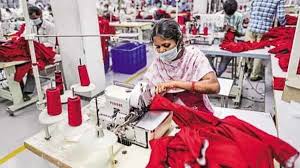
By K Singhania & Co | June 30, 2016
Published in
Stitching up the gaps
Textile Reforms
East Asia has witnessed economic prosperity going hand in hand with speedy expansion in apparels exports in the early stages. Focus of ‘English East India Company’ on the trade of Indian cotton and silk made it one of the richest and powerful corporations in the 18th century. Today, India has the second largest manufacturing capacity in textiles globally that accounts for 13% of the world’s production of textile, fiber and yarn.
Indian textile industry has always acted as a supporting factor in maintaining global trade relations. This industry is the second largest source of employment in the nation after agriculture & any allocation to it has a multiplier effect on the economy at large. But sometimes it lags in terms of competitiveness and productivity. Taking this into consideration, a package of Rs. 6,000 Cr has announced recently to boost the textile industry.
Pitching the right times:
China is starting to exit from textiles and apparel sector due to its rising domestic wages. This leaves a huge demand base for India to exploit. India is well positioned to seize the opportunity of China’s deteriorating competitiveness because wage costs in most of the Indian states are notably lower than China.
But, the hurdle in this path is that the space vacated by China is being filled by Bangladesh and Vietnam which have overtaken Indian apparel exports. Thus, the window of this opportunity is narrowing and India needs to act swiftly to regain competitiveness and apparel market share.
Multi Fiber Agreement was international trade agreement imposing quotas on the amount that developing countries could export in the form of yarn, fabric and clothing to developed countries (was active from 1974 till 2004) .When this Multi Fiber Agreement was phased out, it was expected that India would benefit from it. But the textile industry hasn’t been able to grow up accordingly. Besides, rigidities in the labour market, import restrictions on competing man-made fibers, export quotas on cotton and logistics costs prevented the country from reaping the benefits.
Fortunately, now Indian Government has recognized this second opportunity to capture the market share and competitiveness in global textile marketplace.
Contribution of the sector in social transformations:
Textile sector is labour intensive & has the greatest potential for employment growth. Formal and productive employment generation is necessary in India for social transformation and generation of exports. Thus, Union cabinet’s approval for measures to boost the apparel sector is, therefore, a significant policy initiative.
Also, from social transformation perspective, apparels generate large number of jobs for women, substantially more than in any other sector. India’s low and declining female labour force participation could be similarly boosted by this initiative. This would help to the large extent empowerment of Indian women.
Current Challenges in front of Indian Textile Industry:
Competitors of India are enjoying better market access because of zero or lower tariffs to the exports made by them specially to the US and Europe. However, Indian exports face an average tariff of 9.2%. This gives us clarity about disadvantageous position of India in the global markets. In addition to this external disadvantage, Indian exporting firms are facing a many domestic challenges such as follows:
- The costs and time involved in getting goods from factory to destination are greater than those for other countries. Such cost and time obstacles faced in domestic and international markets reduces the flexibility for manufacturers. Improvement of these logistics and infrastructure issues is expected with the upcoming introduction of Goods & Service tax one of the aims of which is removal of interstate trade barriers & logistic inefficiencies.
- Labour costs, perhaps one of India’s only sources of comparative advantage in this sector, also seem not to work in its favour. This is causing difficulty because of regulations on minimum overtime pay, onerous contributions that become de facto taxes for low-paid workers, lack of flexibility in part-time work, and high minimum wages in some cases.
- Industry suffers the issues of productivity because of the small scale, unorganized and aged nature of our textile business. Around 60% of the spindles used in India are more than 25 years old.
- Another challenge is increasingly shifting world’s demand towards clothing based on man-made fibers. Indian domestic tax policy favours cotton-based production and tariff policy guards an inefficient man-made fiber sector weakening us in the competitive global market.
Policy:
Efforts have been made to address some of the above challenges, leading towards a long way in strengthening India’s apparel industry. Salient features of the package announced are:
- Apparel exporters will be provided relief to offset the impact of state taxes embedded in exports, which could be as high as about 5% of the exports. This is not a subsidy but really a drawback scheme. Rs. 5,500 Cr out of the Rs. 6,000 Cr package is allocated to an additional 5% duty drawback for refunding state levies.
- The Government is deciding to incentivize textile and apparel firms to absorb more labour by offering a pay in portion of the Employees’ Provident Fund for new employees. Hence, firms will be provided a subsidy for increasing employment. This will take the form of government contributing the employers’ 12% contribution to the EPF. The government is already committed to contributing 8.3%, so the new measure will be an addition to that.
- Decision has been made not to exceed workers’ overtime hours above 8 per week leading to increased earnings for the workers.
- Looking to the seasonal nature of the industry, fixed term employment is to be introduced for the garment sector.
- The provision of 240 days under Section 80JJAA of Income Tax Act would be relaxed to 150 days for garment industry.
Also, the Government is sincerely taking into consideration the impact of Indian exporters being deprived in foreign markets. India needs to cautiously weigh the costs and benefits of negotiating new free trade agreements.
It is observed that, industrial policies aiming at promoting particular sector are not without risks. But taking into consideration India’s employment, exports, social transformation, potential competitive advantage and the narrow window of opportunity this risk is worth taking. It is expected that this step will boost exports, increase investment and make the textile industry an integral part of the ‘Make in India’ programme.
Further scope for development:
Though the decision of this package is bold, important & very timely, for the textile and apparel industry to become competitive at an international level, it needs further major revamps such as follows:
- Emphasis should be laid on promotion and marketing of textiles and designs that are indigenous to India. (E.g. Fabindia’s success in branding and marketing Indian designs and textiles in the global apparel market is worth analyzing.)
- Geographical indications could prove to be an effective means of securing a niche market for Indian handloom in foreign markets.
- Given rising Internet penetration in the country, e-commerce could also be used to the advantage of the textile industry to eliminate layers of middlemen and improve access.
Promoting traditional industries does not mean creating a protective shield against the emerging competition from synthetic fiber through tariffs. If the industry has to successfully progress and provide network effects, it must be allowed to grow using its full potential. And for that, it is important to diversify and embrace new innovations.
Subscribe to our Newsletter
Sign up for daily, weekly, monthly newsletter to get the latest news updates delivered directly to your inbox.
Recent Posts
-

Protecting Brands In India And Europe: Comparison Of Trademarks Laws
February 21, 2024



Leave a Reply